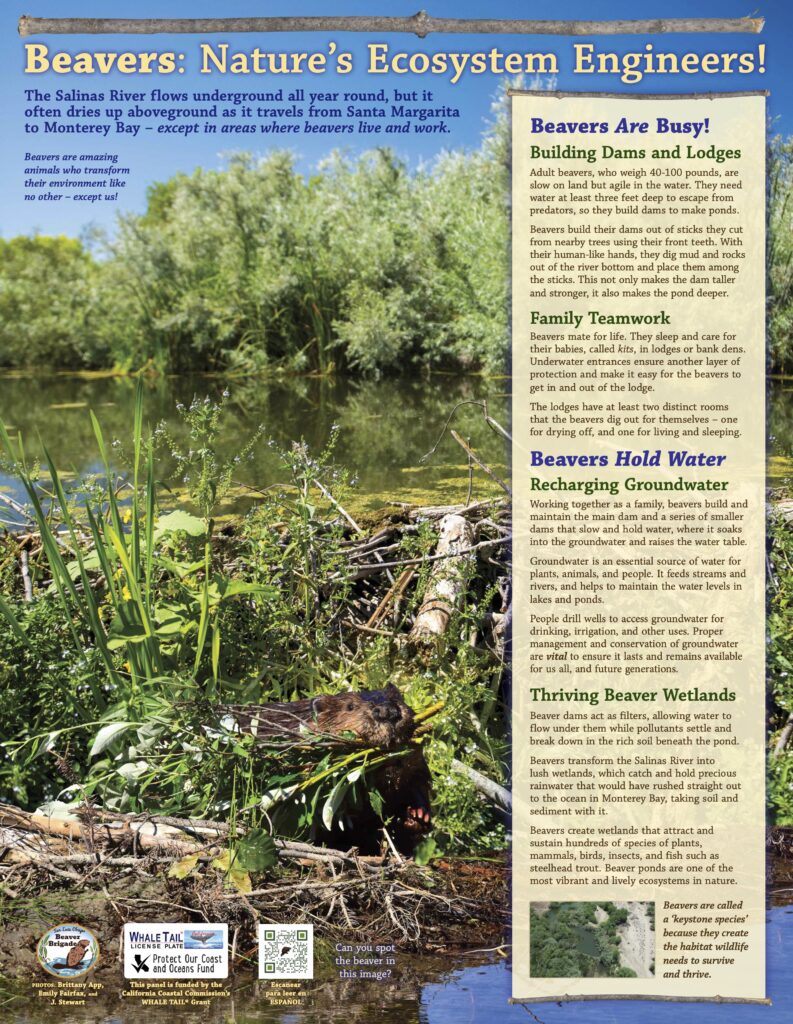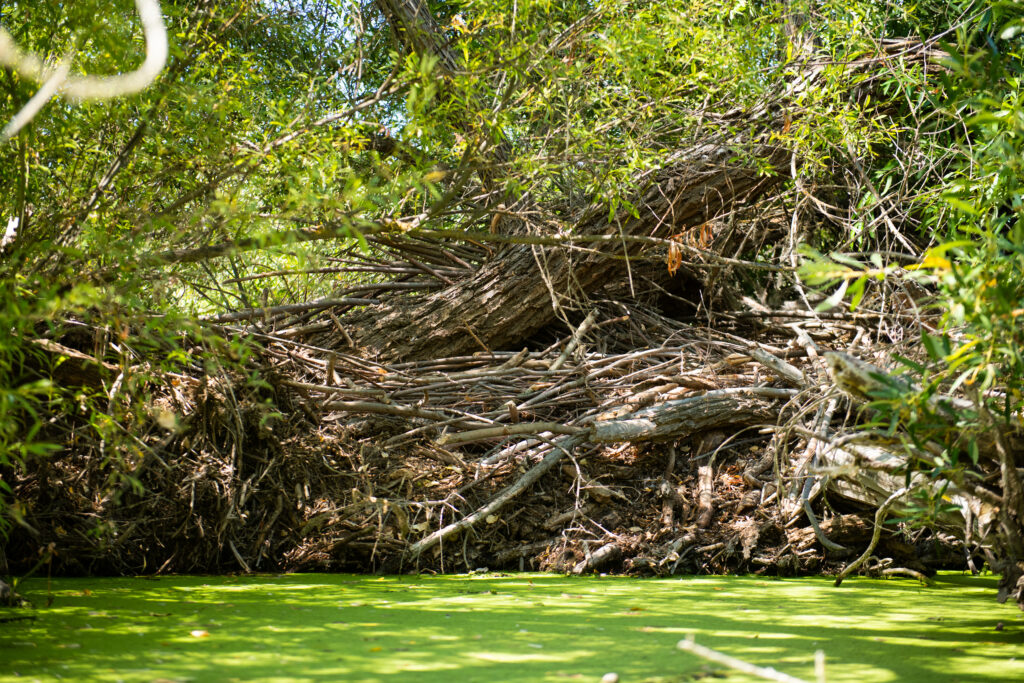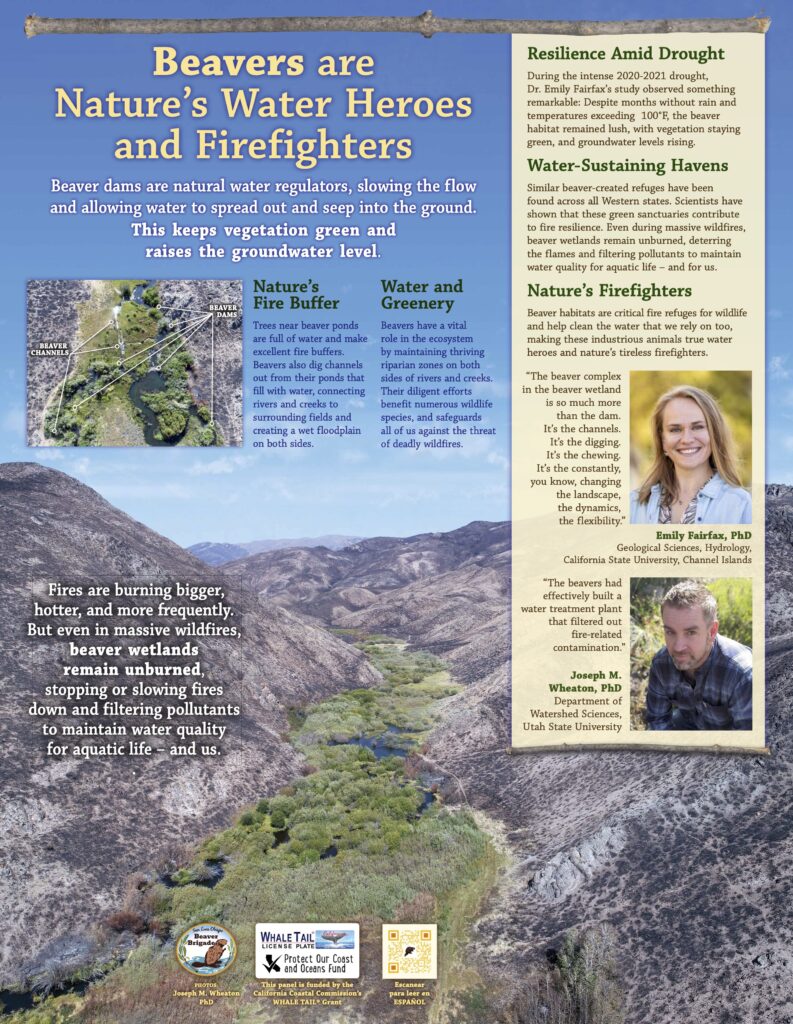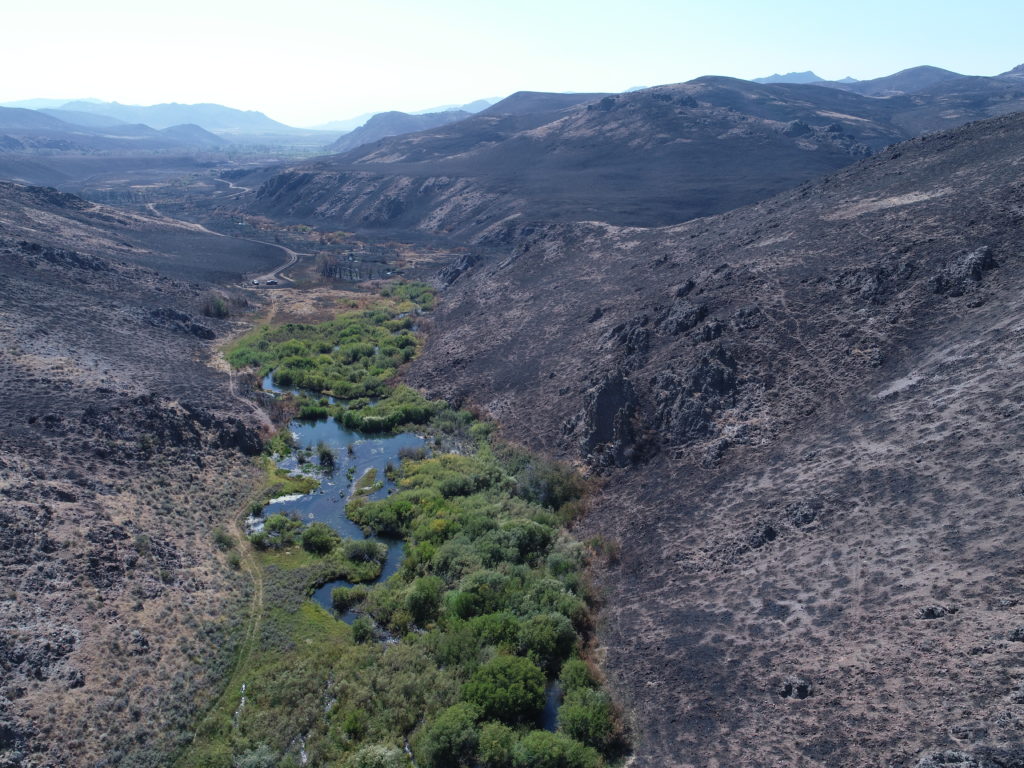Traducción de los Tableros de Información de Atascadero:
¡Castores: Ingenieros del Ecosistema en la Naturaleza!
El Río Salinas fluye subterráneamente durante todo el año, pero a menudo se seca en la superficie a medida que viaja desde Santa Margarita hasta la Bahía de Monterey, excepto en las áreas donde viven y trabajan los castores. Los castores son animales asombrosos que transforman su entorno como ningún otro, ¡excepto los seres humanos!

¡Los Castores Están Siempre Muy Ocupados
Construyendo Represas y Madrigueras!
Los castores adultos, que pesan de 40 a 100 libras, son lentos en tierra pero ágiles en el agua. Necesitan agua de al menos tres pies de profundidad para poder escapar de los depredadores, por lo que construyen represas para crear lagunas.
Los castores construyen sus represas con palos que cortan de árboles cercanos usando sus dientes frontales. Con sus manos parecidas a las manos humanas, excavan barro y rocas del fondo del río para colocarlos entre los palos. Esto no solo hace que la represa sea más alta y fuerte, sino que también hace que la laguna sea más profunda.

Trabajo en Equipo Como Familia
Los castores se aparean de por vida. Construyen madrigueras en la orilla del rio y allí es donde duermen y cuidan a sus crías. Las entradas subacuáticas proporcionan otra capa de protección y facilitan que los castores entren y salgan de la madriguera.
Los castores excavan al menos dos cuartos en la madriguera: uno para secarse y otra para vivir y dormir.
Los Castores Almacenan Agua
Recargando las Aguas Subterráneas
Trabajando en equipo como familia, los castores construyen y mantienen la represa principal y una serie de represas pequeñas que hacen que el agua corra más lento y se almacena agua que se filtra hasta las aguas subterráneas, elevando el nivel de agua.
Las aguas subterráneas son una fuente esencial de agua para plantas, animales y personas. Estas aguas alimentan a los arroyos y ríos, y ayuda a mantener los niveles de agua en lagos y lagunas.
A través de pozos creados por ser humanos, tenemos acceso a las aguas subterráneas: es el agua que bebemos y que utilizamos para el riego de cultivos y muchos otros usos. Es esencial manejar y conservar las aguas subterráneas para que se mantengan para las necesidades de hoy en día y para futuras generaciones.
Humedales – Áreas que Permanecen Con Suelo Saturado – ¡El Éxito de los Castores!
Las represas de castores funcionan como filtros, permitiendo que el agua fluya por debajo de ellas mientras los contaminantes se asientan y se descomponen en el rico suelo bajo el estanque.
Los castores transforman el Río Salinas en abundantes humedales que capturan y retienen el agua de lluvia que habría corrido directamente hacia el océano en la Bahía de Monterey, llevando consigo suelo y sedimento.
Los castores crean humedales que atraen y son hábitat para cientos de especies de plantas, mamíferos, aves, insectos y peces tales como la trucha arcoíris. Los estanques de castores son uno de los ecosistemas más vibrantes y llenos de vida que se encuentran en la naturaleza.
Los castores son una especie clave porque crean el hábitat que la vida silvestre necesita para sobrevivir y prosperar.
¿Puedes encontrar el castor en la imagen del tablero de información?
FOTOS por Brittany App, Emily Fairfax y J. Stewart
Los tableros de información sobre los castores que están en Atascadero son patrocinados por la Comisión Costera de California, Subvención WHALE TAIL®

Los Castores son Héroes Acuáticos y Bomberos para la Naturaleza
Las represas de castores son reguladores naturales de agua, desacelerando el flujo y permitiendo que el agua se extienda y se filtre en el suelo. Esto mantiene la vegetación verde y aumenta el nivel del agua subterránea.
Una Defensa Natural Contra Incendios
Los árboles cercanos a las lagunas de castores están llenos de agua y sirven como excelentes barreras contra incendios. Los castores también excavan canales que se extienden de sus estanques, los cuales se llenan de agua, conectando ríos y arroyos con campos cercanos y creando terreno inundable de ambos lados del río.

Agua y Vegetación
Los castores tienen un papel esencial en el ecosistema al mantener zonas ribereñas prósperas en ambos lados de los ríos y arroyos. Sus esfuerzos diligentes benefician a numerosas especies de vida silvestre y nos protegen a todos contra la amenaza de incendios forestales mortales.
Resistencia en Medio de la Sequía
Durante la intensa sequía de 2020-2021, el estudio de la Dra. Emily Fairfax observó algo notable: a pesar de meses sin lluvia y temperaturas superiores a los 100°F, el hábitat de los castores se mantuvo exuberante, con vegetación verde y aumentos del nivel de agua subterránea.
Refugios Sostenidos por el Agua
En todos los estados del oeste de los Estados Unidos, se han encontrado refugios creados por castores similares a los que se encuentran en Atascadero. Se ha demostrado en estudios científicos que estos santuarios verdes contribuyen a la resistencia contra incendios. Incluso durante incendios forestales masivos, las zonas húmedas de los castores permanecen sin quemarse, deteniendo las llamas y filtrando contaminantes para mantener la calidad del agua para la vida acuática, y para los seres humanos.
Bomberos para la Naturaleza
Los hábitats de los castores son refugios cruciales contra incendios para la vida silvestre y también ayudan a limpiar el agua en la que también confiamos, lo que convierte a estos animales laboriosos en verdaderos héroes acuáticos e incansables bomberos de la naturaleza.
“El complejo del castor en el humedal es mucho más que sólo la represa. Son los canales. Es la excavación. Es el roer constantemente, cambiando el paisaje, la dinámica, la flexibilidad”.
Emily Fairfax, PhD
Ciencias Geológicas, Hidrología,
Universidad Estatal de California, Islas del Canal
“Los castores habían construido eficazmente una planta de tratamiento de agua que filtraba la contaminación relacionada con los incendios”.
Joseph M. Wheaton, PhD
Departamento de Ciencias de la Cuenca Hidrográfica,
Universidad Estatal de Utah
Hoy en día, los incendios están cada vez más peligrosos , más intensos y con más frecuencia. Sin embargo, incluso en incendios forestales masivos, las zonas húmedas de los castores permanecen sin quemarse, deteniendo o desacelerando los incendios y filtrando contaminantes para mantener la calidad del agua para la vida acuática, y para los seres humanos.
FOTOS por Joseph M. Wheaton, PhD
Este tablero de información es patrocinado por la
Comisión Costera de California, Subvención WHALE TAIL®